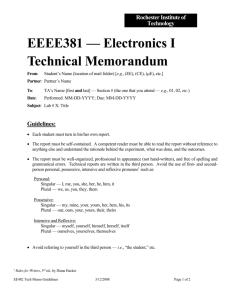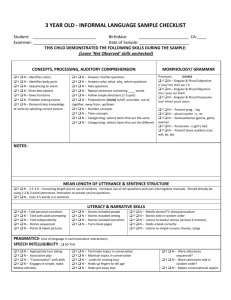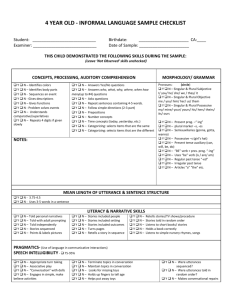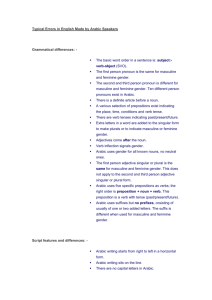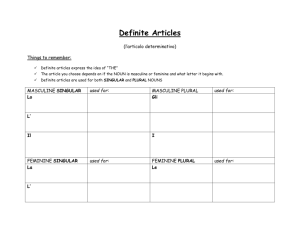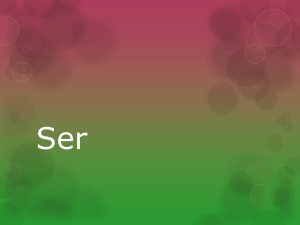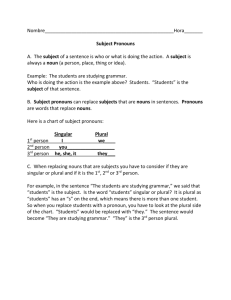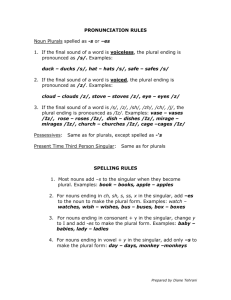Patterns and Suffixes - The Sibaway institute
advertisement
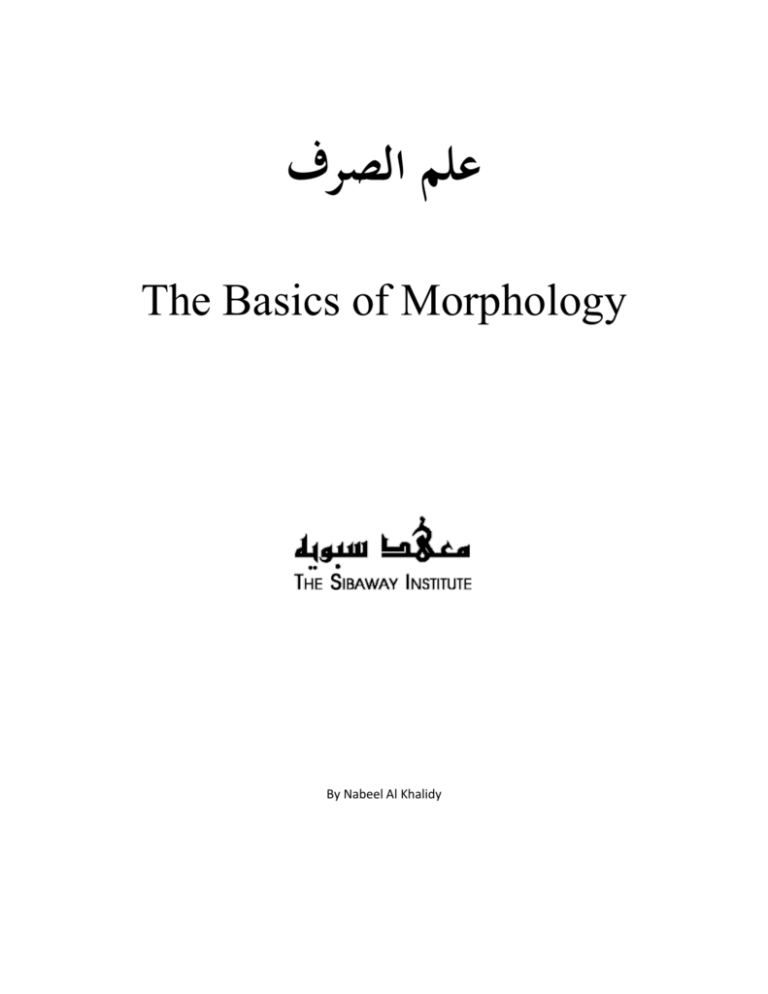
علم الصرف The Basics of Morphology GCSE Arabic By Nabeel Al Khalidy Patterns and Suffixes In the Arabic language, meanings are established by placing base letters side by side in selected patterns. Mostly all combinations of three consonants have been assigned distinct meanings e.g ك ت ب. Words with these letters in this particular order have the meaning associated with writing. In Arabic there are literally dozens, if not hundreds of ways to vowel those three letters, some of which include the addition of ‘non-base’ letters. Depending on the particular pattern, the base-letter meaning of “writing”, will be expressed in a unique way. For instance, ب ََ َ( َكتhe wrote), ب ََ ِ( ُكتit was written), ب َُ ُ( يَكْتhe writes, is writing or will write), َ( كاتِبwriter), َ( َمكْتَبdesk i.e. place of writing), ب َْ ُ( أُ ْكتwrite!) and many, many others. Conjugation Tables In all languages, verbs are conjugated to reflect three aspects of their subjects: Gender — Masculine or Feminine Plurality — Singular, Dual (unlike English, Arabic also has separate forms to indicate on two of something) and Plural (3 or more), and Person — Third person, Second person and First person. This process in English is fairly simple due to the reflection occurring via a separate pronoun. Table 1-A shows what this would look like. Person 3rd 2nd 1st Conjugation Gender He slept Masculine She slept Feminine Plurality Singular They slept Masculine or Feminine Plural You slept Masculine or Feminine Singular or Plural I slept We Slept Masculine or Feminine Singular Plural Table Error! No text of specified style in document.-A : Conjugation of English Verbs As you can see from Table 1-A, the “slept” stays the same through-out, and only the pronoun which is a separate word altogether changes (to reflect those three aspects). In Arabic the three aspects are indicated not by separate words, but by designated letters which are added to the end of the verb as suffixes. These suffixes or designated letters ARE the pronouns and because they are not separate words, verb conjugation is more complex than in English. A great portion of Arabic Morphology is devoted to memorizing the tables that result from MULTIPLYING those three aspects mentioned above (i.e. gender, plurality, and person). In Arabic there are only two genders, meaning Arabic has no ‘it’. All non-human things are categorized as either masculine or feminine. As mentioned above, plurality includes singular, dual and plural. Multiplying the gender (2) with plurality (3), will give us 6. Then taking this 6 and multiplying it with third person, second person, and first person (3), gives us 18. The complete breakdown is shown in Table 1-B. Person Gender Masculine 3rd Feminine Masculine 2nd Feminine Masculine 1st Feminine Plurality English Equivalent # Singular He 1 Dual (2) They (M2) 2 Plural (>2) They (M>2) 3 Singular She 4 Dual (2) They (F2) 5 Plural (>2) They (F>2) 6 Singular You (M) 7 Dual (2) You (M2) 8 Plural (>2) You (M>2) 9 Singular You (F) 10 Dual (2) You (F2) 11 Plural (>2) You (F>2) 12 Singular I (M/F) 13 Dual (2) We (M/F≥2) 14 Plural (>2) We 15 Singular I 16 Dual (2) We 17 Plural (>2) We 18 Table Error! No text of specified style in document.-B : Conjugation of Arabic Verbs – All Possibilities Due to the fact that EVERY subject will need a gender, plurality AND a person, we look at the total combinations that result from multiplying the above. It comes to 18, six for each of the third, second and first persons. For most conjugations there are separate suffixes. However, occasionally, like in almost all languages, two or more conjugations are condensed into one. In Arabic this condensing happens in the first person i.e. ‘I’ and ‘We’, thus reducing the number from 18 to 14. This is because there are no separate dual forms (just singular and plural). Also, gender becomes irrelevant. Therefore, number 13 will be singular first person: ‘I’ and number 14 will be plural first person: ‘We’ (see Table 1-B on the previous page). Each form of the ِ (“seegha”). conjugation table is called a صيغه Active vs. Passive Voice The next thing which is of importance would be what they call active and passive voice. For all actions that require objects (transitive verbs), the verb can either be active or passive. Active is when the verb is directed at the subject which is also mentioned e.g. he helped; whereas in the passive voice the verb is directed towards the object and the subject is missing e.g. he was helped. In Sarf, there are separate conjugation tables for each of the active and passive voices, 14 conjugations per table. In the active table, those designated letters we talked about earlier reflect the three aspects, gender etc. of the subject, while in the passive table it’s the object whose three aspects are being reflected. Essential Note We mentioned in the previous section how base letters (usually three) are put onto patterns to create compound meaning. For simplification purposes, in order to isolate the pattern meanings (subject matter of Sarf) from the meaning coming from the base letters (which are found in dictionaries; not directly a concern of Sarf), the scholars of Sarf have used the most basic base letters in terms of meaning as models for all of the patterns to be discussed through out the science. The three ‘model’ letters are ف, ع, and ل. The meaning associated with these letters is the very simple meaning of ‘to do’. When the Scholars of Sarf use these letters (excluding all other combinations), there purpose is not so you translate the pattern e.g. he did, they did, she did, you did, I did etc. Rather it will be just to show you what pattern of vowellization is associated with what tense etc. So when you have your three letters ready for constructing (they can be any three letters taken from a dictionary), you may now vowel them accordingly and produce the intended compound meaning. This is similar to how a tailor will have many different paper cut-outs of shirts and pants in order to facilitate and simplify his work. Nobody ever attempts to wear the cut-out. Rather they wait until some garment etc. is produced. Likewise, for example, when we say the model pattern for the active past tense verb for tri-literal verbs is ل ََ فَ َع, and for the passive voice it is ل ََ ِفُع, literal translation of each conjugation is never the purpose. Therefore, throughout these discussions we will be only giving the patterns and conjugation tables. We will not make any attempt at translating the tables. Where this is needed, for instance in the very first tables, فعلwill be replaced with other base letters so as to produce clear translations for all conjugations. We will, however, clearly explain the tenses and other distinct meanings associated with the patterns.

